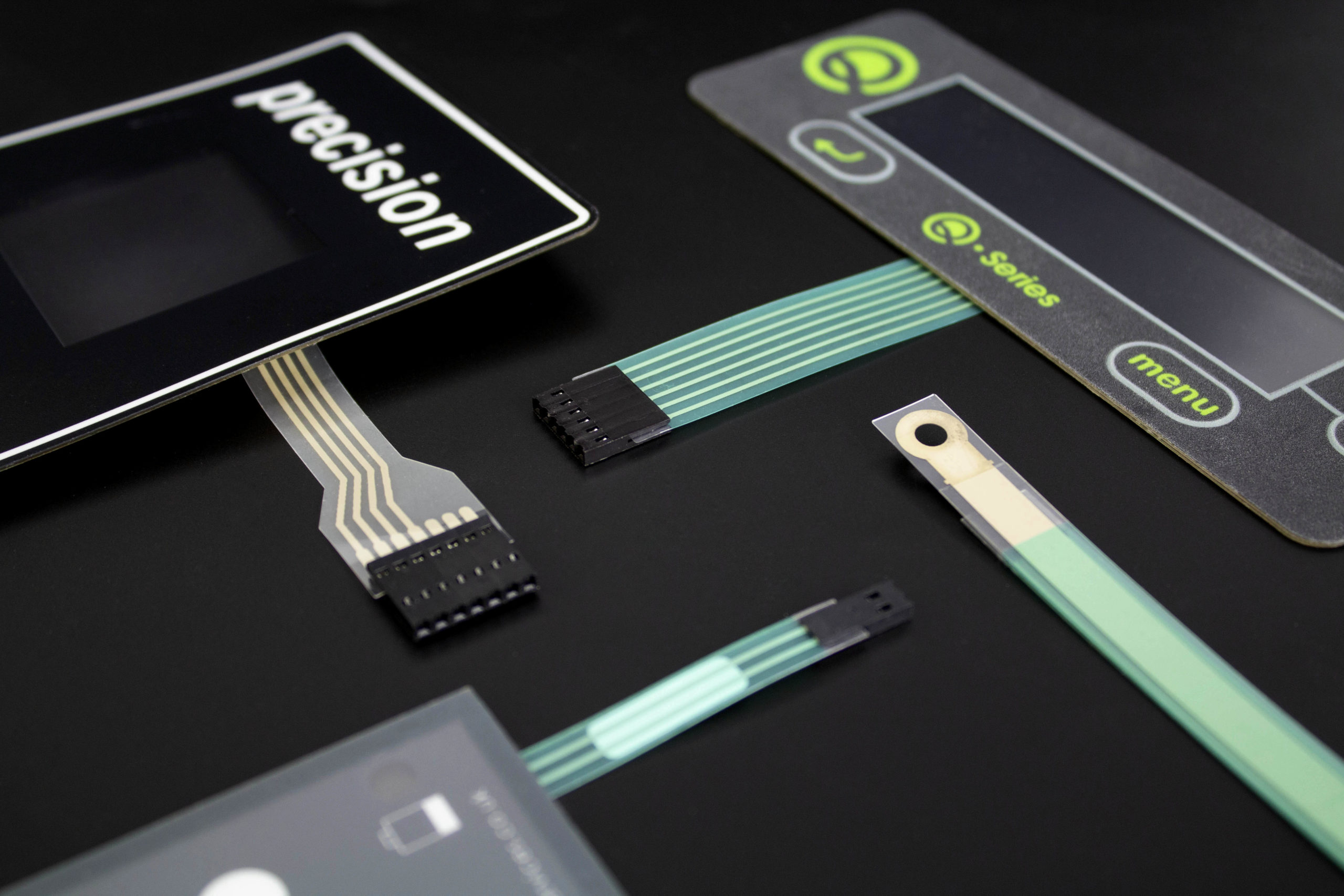Membrane switch in digital appliances: user experience considerations
All Concerning Membrane layer Switch: A Comprehensive Overview for Beginners
Membrane buttons are necessary elements in modern electronic devices, using a special interface for customer interaction - membrane switch. Their split building, including overlays and conductive traces, supplies functionality and durability. Unlike standard mechanical switches, membrane buttons present a smooth layout and adjustable options. Comprehending their key features and benefits can change product style. The intricacies of their application and layout considerations require more exploration.
What Is a Membrane layer Switch over?
A membrane switch is a kind of electric switch that includes a versatile membrane layer layered over a published circuit board. This style enables a small and streamlined user interface, usually utilized in various electronic gadgets. Membrane layer buttons are commonly discovered in customer home appliances, clinical tools, and commercial machinery due to their toughness and resistance to ecological factors.The building and construction generally includes several layers, such as graphic overlays and sticky backing, which supply responsive comments and secure the wiring below. The procedure of a membrane switch is initiated when pressure is applied to the surface, completing an electric circuit.These buttons are valued for their versatility, enabling custom styles and published graphics that deal with details customer interfaces. Their inconspicuous nature minimizes area demands, making them suitable for applications where standard switches may not fit. Overall, membrane layer buttons supply a aesthetic and functional solution for modern-day digital gadgets.
Key Elements of Membrane Layer Changes
Membrane switches over make up a number of key components that add to their functionality and performance. The leading layer, recognized as the overlay, offers the user interface and is frequently published with graphics or icons. Beneath the overlay exists a spacer layer, which separates the conductive elements and protects against unintended activation. The next crucial element is the visuals layer, which improves looks and guarantees the durability of the design.Conductive traces, commonly made from materials like silver or carbon, are published on the circuit layer. When pressure is used to the overlay, these traces come into contact, completing the circuit. Additionally, a backing layer provides architectural support and can be made from products such as polyester or polycarbonate. Together, these elements develop a trustworthy, user-friendly user interface suitable for different applications, from family home appliances to commercial equipment. Comprehending these components is vital for anyone thinking about membrane layer switch innovation.
Just How Membrane Changes Job
Understanding exactly how membrane layer switches function is necessary for valuing their widespread use in different tools. A membrane switch operates with a collection of layers, including a graphic overlay, spacer, and a circuit layer. When pressure is put on the overlay, it presses the spacer layer, permitting the circuit layer to make contact and complete an electrical circuit. This activity sends out a signal to the tool, prompting a feedback, such as activating a light or activating a function.Membrane switches over can be created with numerous attributes, including tactile comments, backlighting, and custom-made graphics, improving customer communication. Their building and construction permits a sealed design, safeguarding the interior components from dust, moisture, and pollutants. This toughness makes them ideal for varied applications, from customer electronic devices to industrial devices. Generally, the simplicity and effectiveness of membrane layer switches over add to their appeal in contemporary technology.
Advantages of Membrane Layer Changes Over Mechanical Switches
While mechanical switches have long been a staple in many tools, membrane layer changes offer distinct advantages that make them significantly appealing. One substantial advantage is their slim profile, enabling for more portable layouts and higher adaptability in product development. In addition, membrane layer switches attribute a consistent surface, which enhances visual charm and simplifies cleansing, making them appropriate for environments where health is critical.Another benefit is their resistance to dust and dampness. Unlike mechanical switches, which can be compromised by ecological aspects, membrane switches give a closed user interface that protects against pollutants - membrane switch. Furthermore, membrane layer switches commonly have a longer lifespan as a result of fewer moving parts, causing improved sturdiness and reliability.Cost-effectiveness is also a remarkable advantage, as membrane buttons can be created wholesale with reduced production expenses. These elements incorporate to position membrane buttons as a practical option to typical mechanical options in different applications
Common Applications of Membrane Changes
Membrane layer switches are widely utilized in numerous industries, especially in customer electronic devices and industrial control panels. In customer tools, they provide a smooth, straightforward interface, while in commercial settings, they enhance toughness and performance. Comprehending these applications highlights the versatility and functionality of membrane layer buttons in modern-day technology.
Consumer Electronics Gadgets
As consumer electronic devices proceed to advance, membrane layer buttons have actually become a popular choice for a range of gadgets because of their adaptability and streamlined layout. These buttons are generally located in smart devices, tablet computers, and remotes, where room is minimal and aesthetic appeals matter. Their low profile and customizable styles enable makers to create straightforward interfaces that boost the total customer experience. In addition, membrane switches are typically utilized in home appliances such as microwaves and coffee machine, offering intuitive control alternatives while standing up to wetness and dirt. The sturdiness and reliability of membrane layer switches over make them appropriate for everyday customer items, guaranteeing longevity and regular efficiency. In general, their assimilation in customer electronic devices mirrors a blend of functionality and modern-day layout.
Industrial Control Panels
The applications of membrane switches expand beyond customer electronic devices, finding significant use in commercial control panels. These buttons are preferred for their toughness and resistance to extreme environments, making them excellent for producing and process control setups. They supply a trusted user interface for operators to manage web link equipment, screen processes, and adjust settings. Membrane layer buttons can be personalized to fit specific functional demands, incorporating functions like backlighting and responsive comments, enhancing customer experience. Their low-profile style permits combination right into various tools, while their ability to stand up to spills, dust, and extreme temperature levels guarantees durability. On the whole, membrane switches add to risk-free and reliable operation in industrial applications, showing their versatility and efficiency in demanding atmospheres.
Factors To Consider for Creating Membrane Layer Switches
When creating membrane layer buttons, picking the best materials is vital to guarantee sturdiness and capability. In addition, recognizing layer configuration techniques can significantly impact the button's efficiency and individual experience. These factors to consider play a vital duty in developing reliable and reliable membrane switch designs.
Material Option Relevance
Product option plays an essential role in the design and functionality of membrane layer buttons. The selected materials directly affect the switch's resilience, tactile reaction, and overall visual. Secret considerations include the substratum, which have to give architectural integrity while permitting adaptability, and the graphic overlay, which needs to be resistant to use and ecological aspects. that site Conductive products should assure trusted electric performance, while adhesives need to supply solid bonding without jeopardizing the switch's operation. Additionally, compatibility with producing processes and end-user environments is crucial; materials must stand up to differing temperatures, moisture levels, and chemical direct exposure. Eventually, ideal material choice not only boosts the membrane layer button's efficiency yet also adds to its longevity and individual fulfillment, making it an important aspect of the style procedure.

Layer Configuration Methods

Regularly Asked Inquiries
For How Long Do Membrane Changes Generally Last?
Membrane buttons normally have a life-span of 1 to 5 million cycles, depending on usage and ecological problems. Elements such as style quality and operating regularity greatly affect their sturdiness and total efficiency long life.

Can Membrane Layer Changes Be Custom-made for Specific Layouts?
Membrane layer switches can without a doubt be personalized to suit specific styles, enabling diverse forms, colors, and capabilities. This versatility allows suppliers to customize these switches to satisfy unique aesthetic and operational needs successfully.
What Products Are Utilized in Membrane Layer Switch Building?
Membrane layer switches are typically built making use of materials such as polyester, polycarbonate, and sticky layers. These materials provide toughness, flexibility, and resistance to ecological variables, making sure the switches function properly in numerous applications and problems.
Are Membrane Switches Over Water-proof or Resistant to Dampness?
Membrane switches can be made to be moisture-resistant, making use of specialized finishes and materials. Nevertheless, visit their website their waterproof capabilities depend on construction top quality and certain applications, making it important to assess demands for ideal performance in numerous environments.
How Are Membrane Changes Repaired if Damaged?
Fixing broken membrane layer changes normally involves changing the impacted layer or circuit. Specialists might likewise apply conductive sticky or utilize specialized repair packages, making certain capability is restored without full replacement of the entire switch assembly. Unlike standard mechanical buttons, membrane layer buttons present a sleek layout and adjustable alternatives. A membrane layer button is a kind of electrical button that is composed of an adaptable membrane layer layered over a published circuit board. The operation of a membrane button is launched when stress is applied to the surface, completing an electric circuit.These switches are valued for their versatility, making it possible for customized styles and published graphics that cater to specific user interfaces. While mechanical buttons have actually long been a staple in lots of devices, membrane layer changes offer distinct benefits that make them progressively appealing. Membrane layer buttons commonly have a longer life expectancy due to fewer relocating components, resulting in enhanced longevity and reliability.Cost-effectiveness is also a remarkable advantage, as membrane switches can be generated in mass with reduced production expenses.